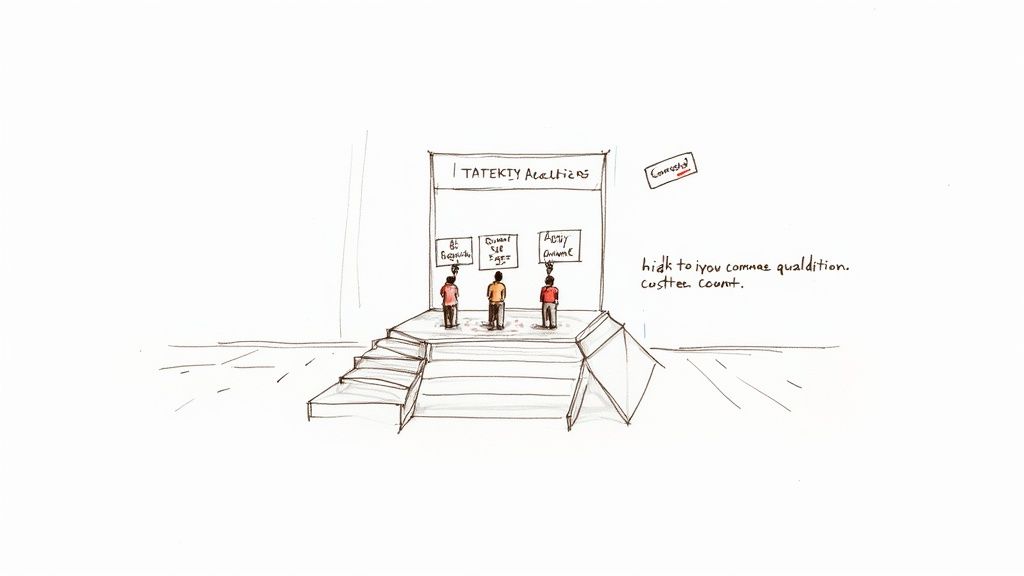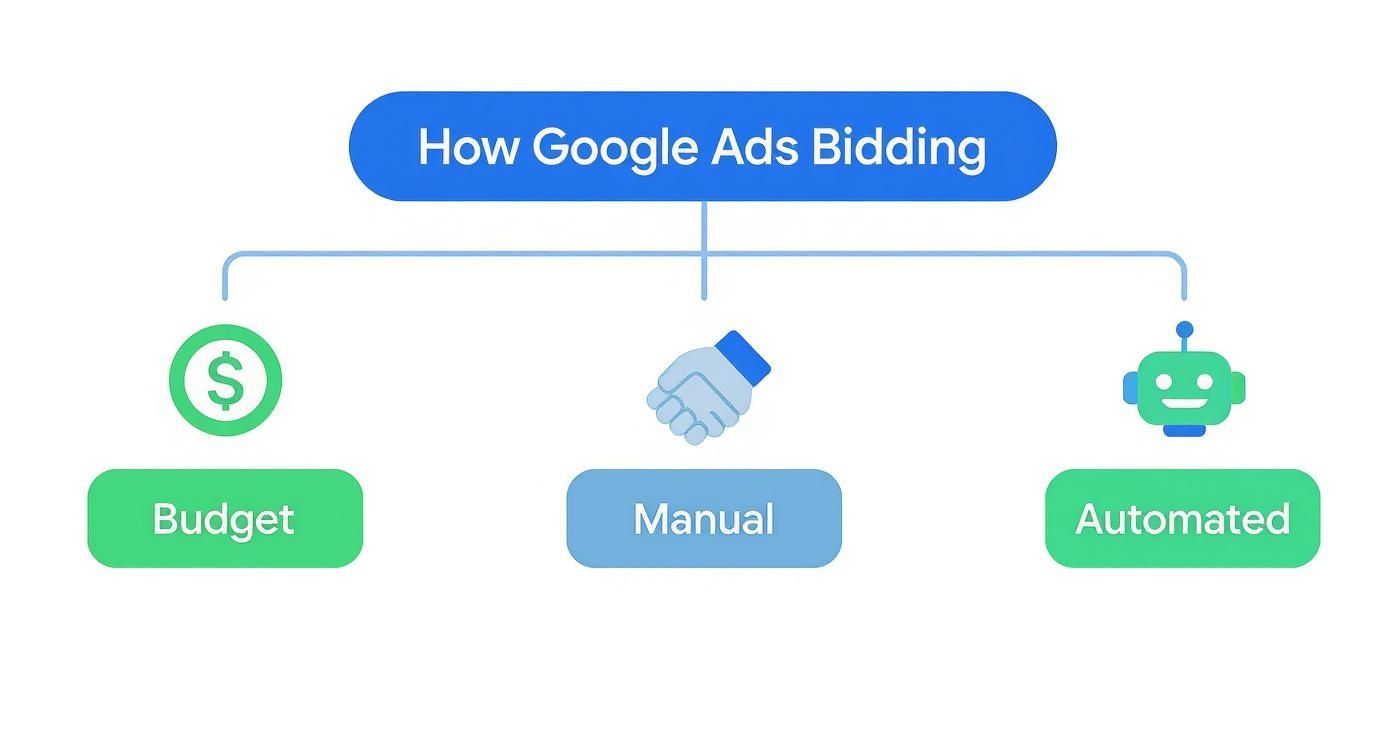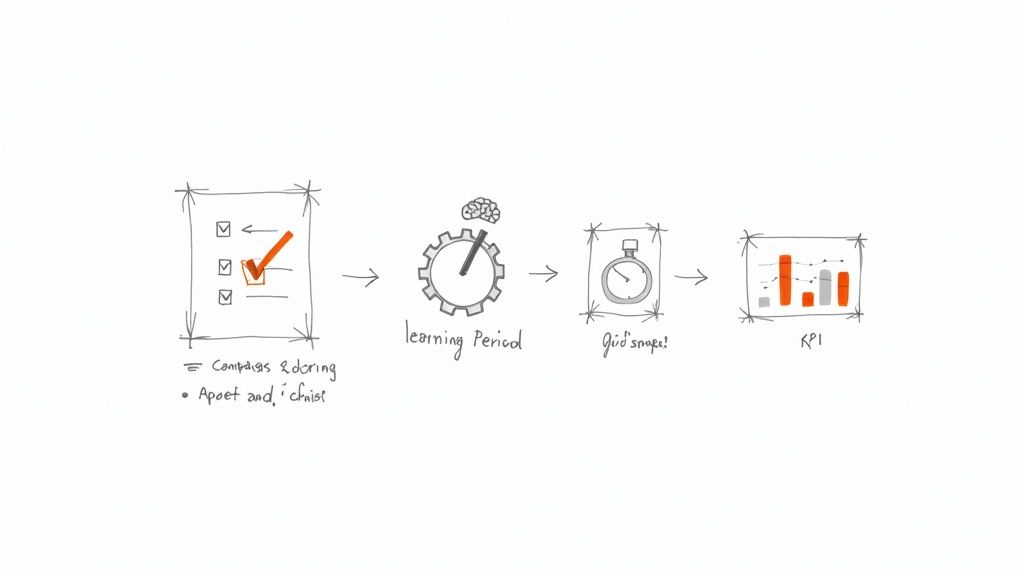
Battling Advertising Fatigue: Strategies to Re-Engage Your Audience
Combat advertising fatigue with strategies to re-engage your audience. Learn to refresh content, optimize delivery, and leverage AI for effective campaigns.

At its core, a Google Ads bidding strategy is how you tell Google you want to spend your money. It’s the set of rules you give the system for how much you're willing to pay whenever someone interacts with your ad.
Picking the right strategy is all about matching your spending to what you actually want to achieve—whether that's getting more eyeballs on your website, collecting email sign-ups, or making sales.

Before you can choose a bidding strategy, you need to understand the auction itself. It’s not a typical auction where the highest bidder automatically wins. It’s much more nuanced.
Every time someone searches on Google, a lightning-fast auction happens to decide which ads appear and in what order. The winner is determined by something called Ad Rank. Think of it as a score that Google calculates on the fly for every search.
So, how does Google come up with this Ad Rank score? It boils down to two main ingredients: how much you’re willing to pay and how good your ad is.
A great Quality Score can be your secret weapon. If your ad is super relevant to the user's search, Google might give you a higher ad position than a competitor, even if they bid more. Why? Because Google’s top priority is giving its users a great experience.
An advertiser with a Quality Score of 10/10 could pay significantly less per click than an advertiser with a 3/10 score for the exact same ad position. Better quality literally means a lower cost to compete.
This system keeps search results from becoming a free-for-all where the biggest companies just buy their way to the top with irrelevant ads. A high Quality Score proves to Google that your ad is a great match for the user, which is a win for everyone. Understanding this relationship between your bid and your Quality Score is the bedrock of any successful Google Ads campaign.
Now, you're at a crossroads: manual or automated bidding?
Think of it like driving a car. You can go with a stick shift for total control, or you can choose an automatic and let the car handle the shifting. Both get you where you're going, but the experience and control are different. This is a fundamental decision in your Google Ads account.
Manual bidding is the stick shift. You're in the driver's seat, setting every maximum cost-per-click (CPC) bid yourself. This hands-on approach is fantastic for surgical precision, especially with a tight budget or when testing a new campaign. Every penny is accounted for because you set the limits.
Then you have automated bidding. This is your automatic transmission. You tell Google your destination—like more conversions or a certain return on ad spend—and its AI does the heavy lifting. It uses machine learning to find the right bid for every auction, saving you time and tapping into massive amounts of data.
These systems look at countless signals in the blink of an eye to set the perfect bid. The most powerful version is Smart Bidding, rolled out in 2016. It focuses specifically on optimizing for conversions or conversion value, factoring in things like a user's device, location, and search history. It needs about 7 to 14 days to learn and requires a healthy amount of conversion data to work its magic. This is a core concept in modern advertising, and you can explore more about data-driven marketing strategies that operate on similar principles.
The choice is between control and efficiency. Manual bidding offers granular control, perfect for new campaigns. Automated bidding provides data-powered efficiency, built for scaling.
So, which is right for you? It all comes down to your goals and how much data you have. Your answer will define how your campaigns perform.
Think of Google's Smart Bidding not as a single tool, but as a toolbox. Each tool is designed for a specific job. Choosing the wrong strategy is like trying to use a hammer when you need a screwdriver—you’ll put in a lot of effort without getting the results you want.
The most important step is to align your bidding strategy with what you’re trying to achieve. Are you trying to get your brand name in front of as many people as possible, or are you focused on driving traffic, generating leads, or making sales? Each of these goals has a Smart Bidding strategy built for it.
This decision tree infographic is a great visual guide for picking the right approach based on your main business objectives.

As you can see, it maps out the entire process, pointing you in the right direction from the start.
If getting seen is your number one priority, focus on strategies centered on impressions and clicks, not direct sales.
Target Impression Share: This one is purely about visibility. You tell Google, "I want my ads to show up a certain percentage of the time at the very top of the page." It’s perfect for brand awareness campaigns where just being seen is the win.
Maximize Clicks: Just like it sounds, this strategy works to get you the most clicks your daily budget can buy. It's a fantastic choice for driving traffic to your site, which is great for building an audience. Just be sure to set a maximum CPC bid to keep costs from getting out of control.
When you’re ready to shift from eyeballs to action, you need conversion-focused strategies. These are the workhorses for most what is performance marketing campaigns, where every dollar is tied to a measurable result.
One thing is non-negotiable: all conversion-based strategies depend on accurate conversion tracking. Without it, Google's algorithm is essentially flying blind.
Let’s look at the heavy hitters:
Maximize Conversions: This is a simple instruction. You tell Google, "Get me the most conversions you can within my budget." It's a great "set it and go" option if your main goal is generating the highest volume of leads or sales.
Target CPA (Cost Per Action): With Target CPA, you get more specific. You tell Google exactly how much you’re willing to pay for one conversion. The algorithm then tries to get you as many conversions as it can at or below that target cost.
Target ROAS (Return On Ad Spend): This is the go-to for e-commerce. It focuses on revenue instead of cost. You set a target return for every dollar you spend (e.g., getting $5 in revenue for every $1 in ad spend), and Google adjusts your bids to hit that goal.
To help you decide, here’s a quick breakdown of the most common strategies.
This table provides a quick look at which automated strategy aligns with different campaign goals, making it easier to select the right one for your needs.
Ultimately, the best strategy depends on what success looks like for your business. Start with the one that most closely matches your primary goal, and don't be afraid to test and adjust as you gather more data.
Picking the right Google Ads bidding strategy is a great start, but getting it live is where the real work begins. Before launching, you must have accurate conversion tracking set up. This is the raw data Google's algorithm needs to learn what works and optimize your campaigns.
With tracking in place, you can select your strategy in your Google Ads account. Once you hit 'go,' your campaign enters the "learning period."
Think of this as the AI going to school. It's gathering data and figuring out how to hit your goals. Be patient. Making changes during this phase will send the algorithm back to square one. Give it about 7 to 14 days to do its thing.

Once your campaign is out of the learning phase, keep a close watch on your Key Performance Indicators (KPIs). The specific metrics you focus on will depend on the strategy you chose.
Remember, a great bidding strategy can't fix a bad website. Getting people to your site is only half the battle. Using a good conversion rate optimization checklist can help you plug those holes and turn more visitors into leads or sales.
Jumping into Google Ads bidding strategies without a plan can drain your budget. A few small missteps can derail a campaign before it has a chance to succeed. Let's walk through three of the most common pitfalls and how you can sidestep them.
This is a classic. You set a target CPA that's way below what your campaigns have historically achieved, thinking you can force the algorithm to be more efficient. The reality is, the algorithm just gets stuck. This mismatch often forces the system back into its learning phase, wasting valuable conversion data.
You're not seeing results fast enough, so you flip from Manual CPC to a Smart Bidding strategy mid-campaign. This is like pulling a plant out of the soil every day to see if its roots are growing. You’re just disrupting the process. Every time you switch, you hit the reset button, confusing the algorithm and often driving costs up.
Smart Bidding strategies are hungry for data. If you don't feed the algorithm enough clean, accurate conversion signals, it’s flying blind. This often happens when conversion tracking is set up incorrectly or you simply don't have enough conversion events for the system to learn from.
A robust, clean conversion feed can improve your bid precision by as much as 30% over time.
Make sure your tracking is solid. Use tools like Google Tag Assistant to test everything. This ensures whatever Google Ads bidding strategies you choose have the quality data they need to work. By steering clear of these common mistakes, you’re setting your campaigns up for consistent, reliable results.
Diving into Google Ads bidding strategies can be overwhelming. Let's tackle some of the most common questions.
Patience is key. When you launch a new Smart Bidding strategy, Google's algorithm needs time to figure things out. This "learning period" usually takes about 7 to 14 days. Think of it as a new employee learning the ropes. It needs to observe and collect data before it can start performing. The most important thing is to leave it alone—making big changes during this window can send it right back to square one.
It’s a common frustration. If your results aren't what you hoped for, first, make sure you've waited out the full learning period. If you have, it's time to check your foundations.
Start with your conversion tracking. Is it firing correctly? Smart Bidding is completely reliant on this data. You'll also want to make sure it has enough data to work with—a good rule of thumb is at least 30 conversions over the last 30 days. Setting unrealistic goals, like a super-low Target CPA, can also suffocate the algorithm.
The number one reason I see Smart Bidding fail is bad data. The algorithm can't optimize what it can't measure accurately.
Not only can you, but you absolutely should! There’s no single "best" strategy for an entire account. The smart move is to match your Google Ads bidding strategies to the unique goal of each campaign. For example, you might run a brand awareness campaign using Target Impression Share while using Target ROAS on your shopping campaign to hit profit goals. Tailoring your bidding this way is how you get the most out of every dollar you spend.
Ready to stop guessing and start getting real results from your ad spend? BrandBooster.ai combines expert human strategy with powerful AI to deliver outcome-driven marketing. We guarantee returns in 60 days, or you don't pay. Learn how we can boost your brand at https://www.brandbooster.ai.